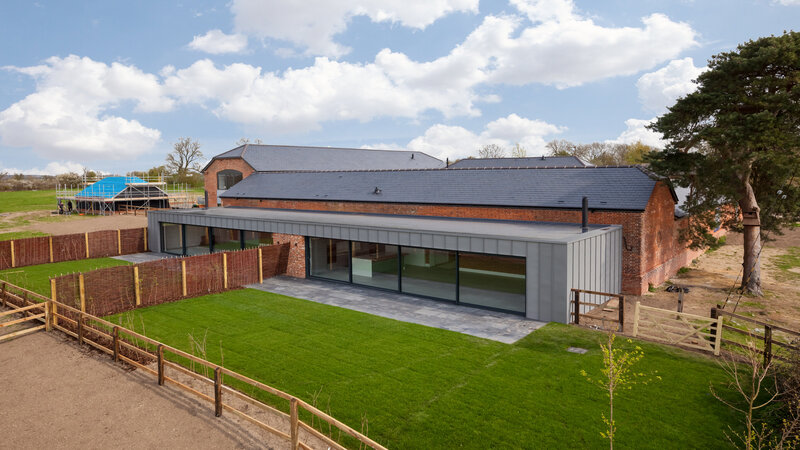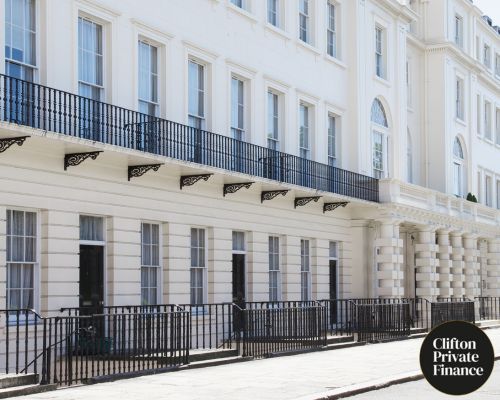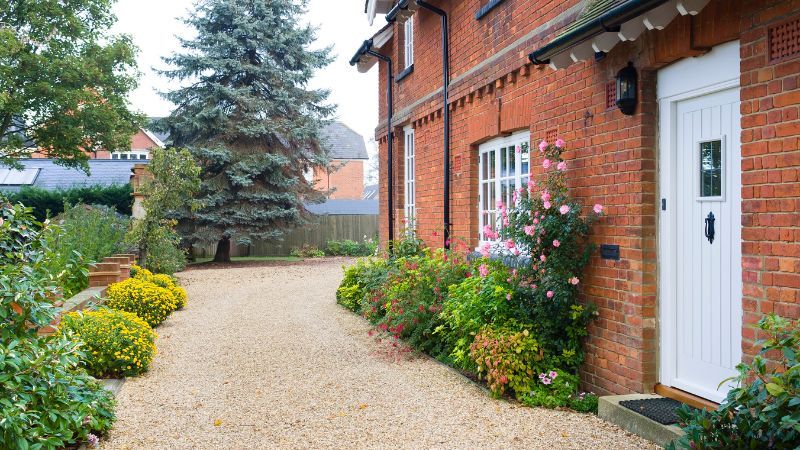Categories
How to Finance a Barn Conversion Using a Bridging Loan

Barn conversions have been a popular way to create stunning rural homes full of character for many years, but as with any conversion of a non-residential building, funding can be an issue. You may not be able to get a mortgage for these builds, but a bridging loan could finance your barn conversion project.
The difficulty is getting a mortgage to convert a non-residential property into a home because mortgages are usually only available for properties considered “habitable”. This means if a property can't reasonably be lived in, you usually won’t be able to get a mortgage on it.
In order to be considered 'habitable', a building needs to:
- Be watertight - with a working roof
- Have a kitchen
- Have a working bathroom
Obviously, a barn isn't likely to have these things, so it's difficult to get a mortgage for these types of conversion projects.
This is why bridging loans provide a vital lifeline for barn conversions. Bridging loans have become increasingly popular in the past decade, especially for conversion and renovation projects.
Bridging loans are:
- Fast
- Flexible
- Short-term
Bridging loans are typically repaid at the end of the loan term (usually 12-16 months), by which point the project has been finished. They can be financed to a mortgage or repaid through the sale of the property, making bridging finance especially suitable for property flipping.
Why Bridging Loans are Ideal for Barn Conversions
A bridging loan is a type of short-term loan which can be secured on a property and allows you to borrow similar amounts to a mortgage. The key difference, though, is that a bridging loan can be secured on an unmortgageable property.
This means you can use a bridging loan to borrow the money to buy and convert a barn, turning an unmortgageable property into a mortgageable home.
Bridging loans can be arranged fast, making them a good choice if buying at auction, and can be secured on more than one property if you need to borrow more or want to get a more attractive interest rate.
When used for development finance, bridging loans can usually be taken in instalments, giving you a steady cash flow while keeping your interest payments down. This is because you will normally only pay interest on the money you have already taken.
This means bridging finance offers a fast, affordable and convenient way to finance barn conversions or any other kind of property development involving an unmortgageable property.
Watch our short video below for everything you need to know about bridging loans:
How Bridging Loans Work
Bridging loans are usually offered for 1 to 18 months, although longer loan terms can often be arranged. A loan can sometimes be agreed upon in as little as 5-7 working days, allowing your development to move forward quickly.
For a barn conversion, the amount you can borrow will usually be based on the project’s gross development value (GDV), i.e. how much the property is likely to be worth once completed. Typically, you can borrow up to 65% of the GDV for a barn conversion.
Related: Bridging Loan to Buy a House: Example of How it Works
How Much Do They Cost?
You'll normally pay an arrangement fee for taking out a bridging loan, typically 1-2% of the total capital borrowed. Interest can be paid monthly, but it is more typical with development projects to roll up the interest and pay it as a lump sum when the capital is repaid.
You'll need to specify an exit strategy when taking out bridging finance, i.e. explain exactly how you will repay the loan. For most barn conversions, this will either mean refinancing with a mortgage, selling an existing property such as your previous home, or selling the finished barn conversion property.
You may have to pay an exit fee when you repay the bridge, typically 1-2% of the capital. Not all lenders charge exit fees, so this is an important condition to look out for when calculating which lenders offer the best deal on bridging finance.
Related: How Much Does a Bridging Loan Cost?
Use our bridging loan calculator below to see how much you can borrow and get an idea of any costs and fees.
Applying for Bridging Finance for a Property Conversion
Bridging loans are not normally available direct to borrowers as they are usually only offered by private banks and dedicated intermediary-only subsidiaries of high street banks. This means that to access bridging finance, you'll normally need to apply through a bridging loan broker.
A good, independent bridging loan broker with whole of market access (such as Clifton Private Finance) will be able to quickly find you the best rates from across the industry. This means you get the money you need fast and with minimum stress, so you can focus on your property project.
Read blog: How Clarkson's Clause Has Changed Agricultural Permitted Development
Find the Best Rates on Bridging Finance for a Barn Conversion
Clifton Private Finance has established relationships with all the leading bridging finance lenders, so we can always find you the best rates currently available.
We have an award-winning team of bridging finance specialists offering a fast, friendly and professional service. Whether you're new to the world of bridging or you're simply looking to secure market-leading rates, we can guide you through your options.
To see what we can do for you, call us at 0117 959 5094 or book a free consultation below.
FAQs
Yes, a valuation is typically required for a bridging loan in the UK. Since bridging loans are often secured against a property or other valuable assets, lenders will want to assess the market value of the property being used as security. This helps the lender determine how much deposit they want you to provide based on the value and condition of the property. You can borrow up to £25m with bridging finance, but it’s typically capped at about 80% of the value of the property you’re using as security. It's important to note that different lenders have varying policies and criteria regarding the maximum loan amounts they offer for bridging finance. Some lenders have a maximum limit of over £1 million, while others may specialize in smaller loan amounts. Additionally, the terms and conditions of the loan, including interest rates and fees, should also be taken into consideration when determining the overall affordability of the bridging loan. Yes, you typically need a 20-40% deposit for a bridging loan. It can be possible to get a bridging loan without a deposit (a 100% bridging loan), but you’ll need other assets in the background to secure the loan against, and more stringent criteria and higher costs could apply. Yes, it is possible to get a 100% bridging loan (also known as a 100% LTV bridging loan), but it is rare. This means that you won’t need to put down a deposit and can borrow the full value of your property. However, the criteria for these loans can be hard to meet, and you’ll need to provide additional assets as security for your loan. Interest rates and fees can also be higher to compensate. While using bridging finance doesn’t technically make you a cash-buyer, it can allow you to act like one. Mortgages take months to process, often leading to an ‘onward chain’ where all parties involved need to wait for funds to be transferred. Bridging finance can usually be accessed a lot quicker than mortgages so you can bypass the onward chain, giving you an advantage over other buyers and being attractive to sellers. Bridging loans typically have a term of 12 months, but some lenders are willing to stretch their terms to 18 months, or even 2 –3 years depending on the case. Terms longer than 2 years will usually only be considered for specific cases. Yes, you can use a bridging loan to pay Stamp Duty. This amount could be covered by a bridging loan, providing you have a way to repay the additional borrowing amount to your lender. Yes, bridging loans are safe when they’re used in the right circumstances with a solid repayment strategy. However, we recommend speaking to a qualified advisor, like our brokers at Clifton Private Finance, before you take out a product. The main factors to consider with bridging finance are that the full loan amount will usually need to be repaid within a year, and like a mortgage, it is secured against a property as collateral. This means that in the case that you aren’t able to repay your bridging loan, your property would be at risk of repossession. But with a watertight exit strategy, bridging finance can be an efficient way to secure property quickly. Bridging loans are designed to be short-term so there’s no maximum age limit when applying for a bridging loan. This does depend on the lender, as some bridging lenders do have an upper age limit, but there are lenders on the market who offer bridging loans for borrowers aged 70 and over. Bridging loan interest rates usually range between 0.45% - 2% per month, depending on the case and the market rate. Unlike mortgage interest rates, bridging loan interest is calculated monthly instead of yearly. This is because bridging loans are short-term and, in many cases, repaid within a year. Bridging loans can be arranged without early repayment penalties, so interest is calculated monthly to ensure you only pay interest on the months you have the loan for. Unfortunately, mainstream banks in the UK don’t offer bridging loans. This means that if you’re looking for a bridging loan, you won’t be able to get one using a lender you’d find on the high street. There are a variety of specialist lenders that offer bridging loans, but because these lenders are smaller and more niche, you may need a bridging broker to access them. Banks typically charge two main fees when taking out a bridging loan – arrangement fees and interest. But there are other costs to consider such as valuation fees, broker fees and administration fees. Costs can vary from lender to lender, and will also depend on what your bridging loan is for (e.g., residential or commercial purposes.) Arrangement fees are what the lender charges you to take out the loan and can range between 1.5 - 3% of your overall loan. Bridging loan interest, on the other hand, is calculated monthly. This can catch borrowers out who may be expecting an Annual Percentage Rate (APR) like with a mortgage. Yes, you can convert a bridging loan to a mortgage through refinancing, and it is common among borrowers who use bridging finance to buy residential properties. However, whether or not you’ll be able to refinance to a mortgage is dependent on your financial circumstances, the lender, and the property you’re planning to buy. It’s important to be sure that refinancing is a viable repayment option before you take out a bridging loan on a residential property. Yes, bridging loans are typically more expensive than mortgages. Bridging loan interest rates can be much higher than a mortgage, and are calculated and displayed as monthly rates instead of the usual annual percentage rate (APR) that you’ll see on a mortgage. However, bridging loans are a short-term solution, and you’ll only pay interest on the months you’ve borrowed money for – and you can repay early without any charges (for most loans). There are many circumstances where bridging loans are an affordable option and a means to an end - for borrowers that need to finance a property purchase quickly, it may be the only option available. The two most common ways to pay a bridging loan are to sell a property or refinance to a mortgage. You may also need to ‘service’ the loan through the term, which means paying the interest monthly. However, you can opt to ‘roll up’ your bridging interest to be repaid at the end along with the capital. There are also other ways to repay a bridging loan, such as selling a business or even using money from an inheritance. The method in which you pay your bridging loan can be flexible, just as long as it is clear in your application that you have a surefire way to repay your loan when the terms are up. In most cases, a bridging loan will require a minimum deposit of 25%. However, the minimum can vary depending on the lender and the specific circumstances of the loan itself. Generally, bridging loans are secured against a property or other valuable assets, and the deposit required is often expressed as a percentage of the property's value, known as the loan-to-value ratio. In some cases, 0% deposit bridging loans are an option, but only if you have other property or assets in the background to provide additional security. No, typically, you’ll repay a bridging loan in one chunk at the end of the loan term. Bridging loans are a form of short-term finance and will usually need to be repaid within 12 months, but there can be room for flexibility. In some cases, borrowers may be required to make monthly interest payments. This means that each month, you would pay the interest accrued on the loan amount while the principal amount remains outstanding until the end of the loan term. But usually, the interest is "rolled up" or added to the loan balance and paid with the rest of the loan at the end of the term. This option can help protect your cashflow so you can spend it on moving costs or refurbishments, for example. Bridging loans can be arranged in as little as 7 working days. However, it depends on the complexity of the bridge loan and your specific circumstances. It may also be more expensive for you to rush an urgent application through – but not impossible. Bridging loans are a popular option for borrowers who are under time constraints, such as buying a property at auction or breaking a chain. The key factors lenders tend to consider are: Security - Bridging finance is usually secured against property or other valuable assets. Lenders will assess the value and marketability of your security. Exit Strategy - Lenders will want to understand how you plan to repay your bridging loan. In most cases, this is selling your old property, selling the new property (flipping), or refinancing with a long-term mortgage. Loan-to-Value (LTV) Ratio - Lenders consider the loan amount compared to the value of the property being used as security as a percentage. The LTV ratio can vary, but most lenders will have a maximum of 60-80% LTV. Remember, the criteria for obtaining bridging finance in the UK can vary depending on the lender and your circumstances.
Do you need a valuation for a bridging loan?
How much can you borrow with bridging finance?
Do you need a deposit for a bridging loan?
Can I get 100% bridging finance?
Does a bridging loan make you a cash buyer?
What is the longest bridging loan term?
Can I use a bridging loan to pay stamp duty?
Are bridging loans safe?
Can an 80 year old get a bridging loan?
What is the monthly interest rate on a bridging loan?
Do banks still do bridging loans?
How much do banks charge for bridging loans?
Can you turn a bridging loan into a mortgage?
Is a bridging loan more expensive than a mortgage?
How are bridging loans paid?
What is the minimum deposit for a bridging loan?
Do you pay monthly payments on a bridging loan?
How long does it take for a bridging loan to come through?
What is the criteria for bridging finance?











